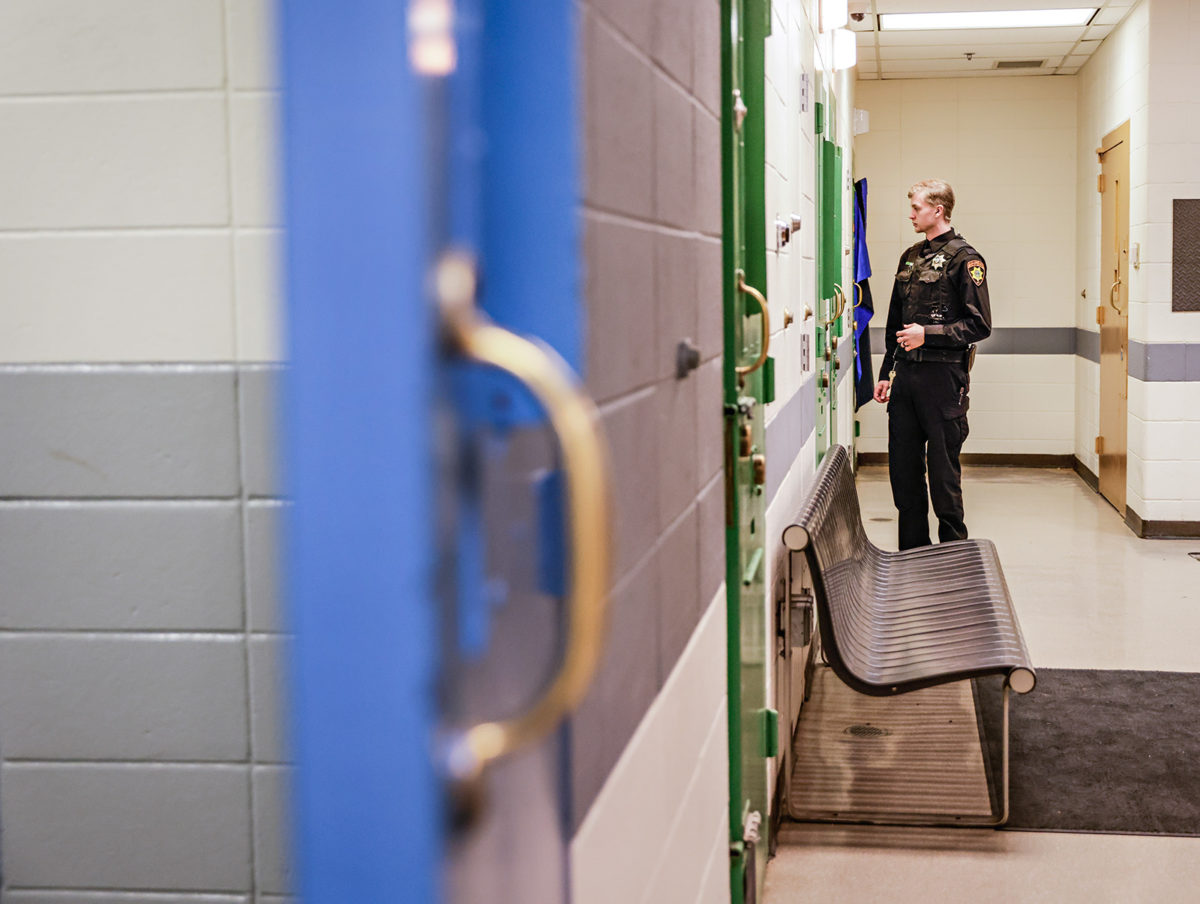Stretched Thin
The Flathead County Sheriff’s Office is operating with about the same number of resources it had a decade ago, even as the valley’s population, 911 call volume and violent crimes continue to spike
By Maggie Dresser
On April 25, Flathead County Sheriff’s Office (FCSO) deputies traveled to Polson to assist in the arrest of 13 residents who were allegedly connected to a drug-trafficking ring. The next day, the agency’s SWAT teams responded to a transient man who allegedly threatened to shoot law enforcement on Montana Highway 35. On April 27, deputies arrested a man following a high-speed car chase that ended in a standoff with authorities in Columbia Falls.
“We had three SWAT calls in three days,” Flathead County Sheriff Brian Heino said. “That’s never happened before.”
While Heino describes the timeframe of these three high-priority calls as an anomaly, it’s reflective of a local trend — a dramatic increase in call volume, including more violent and complex crimes, as Flathead County’s population explodes.
According to 2020 U.S. Census Bureau data, Flathead County grew by more than 15% since 2010, adding more than 13,000 residents.
But as the county sees significant growth and the sheriff’s office has received 6,000 more calls per year compared to 2018, the department has stayed relatively the same size. Aside from a few grants that have temporarily funded school resource officers and Internet Crimes Against Children (ICAC) Task Force Program positions, Heino says county administrators have added one deputy position to the budget in the last 10 years. County officials say two deputies were added to the budget in 2017.
In addition to population growth, the county has also seen a 5% increase in crime between 2020 and 2021, reflecting statewide and nationwide trends. The U.S. murder rate rose 30% between 2019 and 2020, according to Centers for Disease Control and Prevention (CDC) data. Locally, domestic violent crimes in Flathead County have increased 20% and other violent and mental health-related calls have spiked, requiring more resources.
“These responses take manpower,” Heino said. “When you say you’re going to shoot at us, we kind of have to believe you. Our main goal is to end things in a peaceful way, and it takes resources to do that.”

The FCSO covers 5,280 square miles with 63 sworn-in deputies and a ratio of one deputy per 1,760 people. The national standard is a ratio of 2.5 deputies per 1,000 but many Montana counties operate with a one to 1,000 ratio, Heino said.
According to a recent study from the Montana Board of Crime Patrol, Flathead County is the least staffed in the state, with 63 sworn-in deputies making up a full roster. Of those positions, 61 are funded within the county’s budget while two of those positions are temporarily funded through grants.
But realistically, Heino says the department rarely operates with its full staff. With two deputies on military deployment, one deputy on medical leave, four in training, two at the police academy and other individuals seeking sick time, vacation and leave, the FCSO usually operates closer to a staff of 55.
To cover the sprawling county, there are usually six deputies on duty per shift, including a day, night and swing shift. With one deputy posting per zone, the FCSO is divided into zones across the county, covering the northern region, which stretches from Olney to Essex; the eastern region near the Swan Mountain Range; the southern region from Lakeside to Ferndale; and the local zone, which is the busiest, stretching from Evergreen to west of town. The remaining deputies on shift are rovers and floaters.
While some calls can be handled with one deputy, violent calls require multiple resources. If disturbances happen simultaneously, sometimes the FCSO is left with no one available to respond.
“When you say you can no longer do things and your responsibility is public safety, it wears on you at night,” Heino said. “You start to worry about your guys. When you don’t have enough people to respond to calls, you worry about the community. There’s not the coverage that we used to see and you worry about the quality and time being spent on investigations. All of those dynamics run through your mind.”
To keep up with the calls, Heino is requesting five more deputies, two additional ICAC deputies, two more court staff and a fifth judge for the 2023 fiscal year. For 2024, Heino is requesting four more deputies.
As Flathead County officials review the budget for the upcoming fiscal year, which will be approved in June, Commissioner Pam Holmquist and County Administrator Pete Melnick say it’s too early in the budget process to tell if the department will receive more funding.
“The sheriff submitted a very thoughtful and responsible budget to address the growth in the valley and to address the public safety that commissioners put high value on,” Melnick said. “The commissioners do want to support the sheriff as best we can, understanding we are under fiscal constraints.”
According to the Flathead County budget for fiscal year 2022, commissioners approved a $15.4 million budget for the FCSO, a 4% increase from the year before, and Melnick says the total budget ended up at $15.8 million for the year.
County officials are also trying to find a location for a new detention facility, which right now has $7 million budget. The current jail technically has a maximum capacity of 154, but Heino says they typically cap the number of inmates at 107. With a high volume of mentally ill inmates, many of them require single-cell units. Heino would like to see a 260-inmate cap in the new jail with a free-flow design.
Even if the county approves the sheriff’s requests, employee recruitment remains a challenge. The FCSO has operated understaffed during much of the pandemic and Heino only recently reached a full staff due to recruitment issues.
Historically, the FCSO received hundreds of applications for law enforcement positions; now, Heino says the department sees fewer than 30, which he attributes partially to a lack of housing in the valley. Detention officer positions are even more difficult to fill, Heino says. There will soon be five detention officer vacancies with almost no applicant pool.

“We’ll get five applicants if we’re lucky,” Heino said.
Entry level detention officers earn an hourly wage of $19 per hour while deputies start at $28 per hour, Heino says.
Employee retainment is also becoming more difficult, with law enforcement officers retiring after 20 years as opposed to 25 to 30 years in the past.
“That’s five people per year retiring,” Heino said. “You are automatically trying to fill those roles.”
In 2021, there were 12 deputy retirements.
As the valley’s population grows, the complexity of calls has also grown. Deputies have been responding to significantly more mental health-related calls, which Heino attributes to higher community stress and a lack of in-person services in the beginning of the pandemic
There were about 300 more mental health crisis calls and 200 more domestic violence crisis calls in 2021 compared to 2019, according to FCSO data. During the busiest month in July, there were about 200 more high-priority incidents in 2021 compared to 2019.
The spike in complex calls is impacting staff members, Heino says, with post-traumatic stress disorder (PTSD) contributing to the departure of deputies. For example, since the pandemic began there were six officer-involved shootings leaving four men dead. Before 2020, it had been more than 13 years since the FCSO had been part of a shooting that left a suspect dead.
In June of 2020, a triple homicide in Olney that involved a man murdering his estranged wife, their 3-year-old daughter and another man took a toll not only on the Flathead Valley, but law enforcement officers who responded to the incident.
“One thing we do need to get better at is the mental health of our employees,” Heino said. “The triple homicide definitely contributed to turnover.”
As dramatic call volumes rise, there’s been a 23% increase in cases being investigated by detectives. But with few resources, Flathead County Undersheriff Wayne DuBois said deputies aren’t always able to conduct thorough investigations, which can leave gaps.
Insufficient evidence collected in some cases means the Flathead County Attorney’s Office (FCAO) can’t always prosecute cases.
“When your call loads increase and you don’t have enough people, especially if you’re getting these priority calls, deputies are spending less time,” DuBois said. “When you are talking about the whole process and prosecution, an element is what kind of product are we delivering to the (county attorney’s) office? … It may not even be prosecutable.”
Flathead County Attorney Travis Ahner calls these “abbreviated investigations,” where authorities have to rush through witness statements, and they aren’t able to collect the sound evidence that his office needs to effectively prosecute cases.
Compared to a few decades ago, officials say there’s a much higher standard for prosecution since body cameras have become the norm and there are more requirements for evidence.
“There’s an expectation of a higher level of evidence,” Heino said. “Higher than any of us have seen before and it’s hard for some of us old dogs to adapt. We’re at a transition where everything is video-taped, and everybody is video-taping us and there’s this weird dynamic.”

Reviewing cell phone data and camera footage is just one more aspect of a detective’s job, eating up more time and resources, Ahner said.
“Our judges and juries are rightfully demanding because we’re dealing with significant issues in the types of crimes and we really want to make sure we get things right,” Ahner said. “With proliferation of cell phone data and surveillance footage, people just have this idea in their head of what they want to see when they come into court as the jurors.”
But adding more deputies might not help the county attorney’s office. Additional deputies would likely contribute to a higher number of cases and a greater workload for the county attorney.
According to data compiled by Ahner, Flathead County has the second highest caseload in the state behind Yellowstone County.
Each Flathead County attorney has 90 to 95 active felony cases per year, Ahner said.
“Our attorneys are incredibly busy,” Ahner said. “If you add more law enforcement, then you will have more cases.”
“I would like to see our attorney to case ratio decrease,” he added. “They are essentially the lowest paid attorneys in the valley and have arguably the most stressful and thankless jobs.”
When Heino was first elected sheriff in 2019, he had a goal of increasing public relations and services around the county. He launched the K9 program, brought in school resource officers through grants and worked to build relationships with kids and schools.
“When you see this reduction in staff, it’s a lot harder to do this public interaction stuff,” Heino said.
The FCSO relies heavily on volunteers for major events like the Northwest Montana Fair and Under the Big Sky Festival. The Flathead County Sheriff’s Posse has 60 volunteers who maintain a presence and communication with deputies. Between the sheriff’s posse, Flathead County Search and Rescue and North Valley Search and Rescue, volunteers donate thousands of hours per year, Heino said.
Before staffing became so tight, there was a proactive law enforcement team of four to five people that was targeting narcotics and thefts, which included many cases that were federally prosecuted.
But now, FCSO teams are mostly reactive, responding to an average of 92 reactive calls and 36 proactive calls per day in 2021.
“You get that feeling that you just can’t catch up,” Heino said.